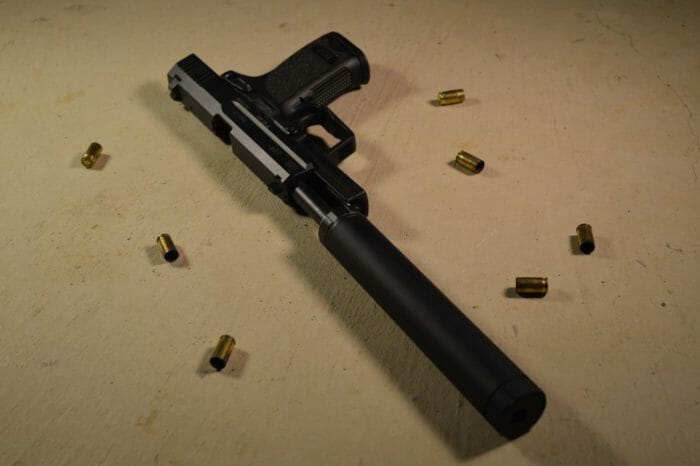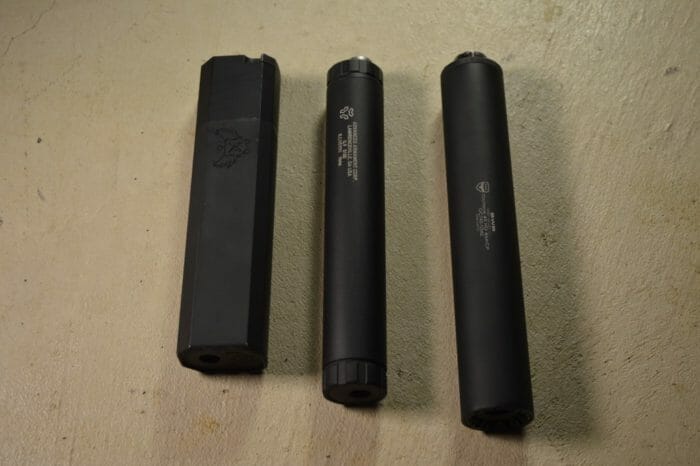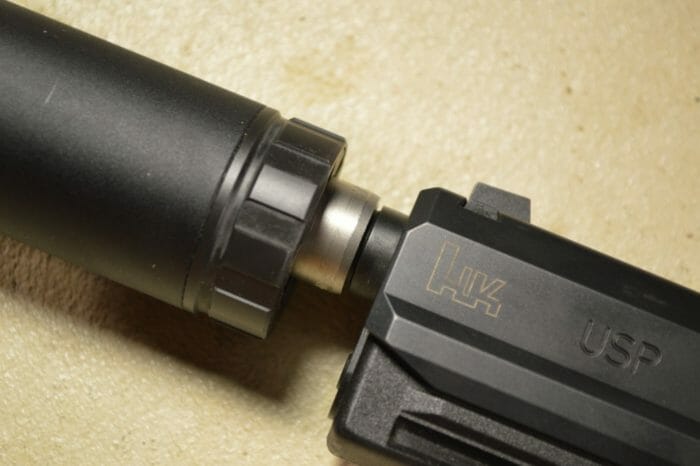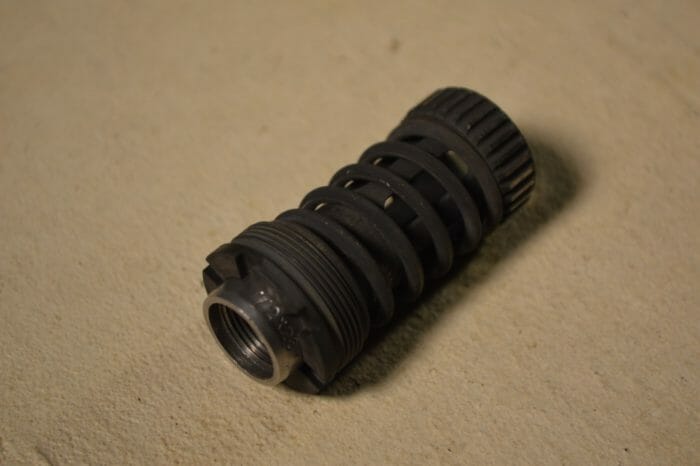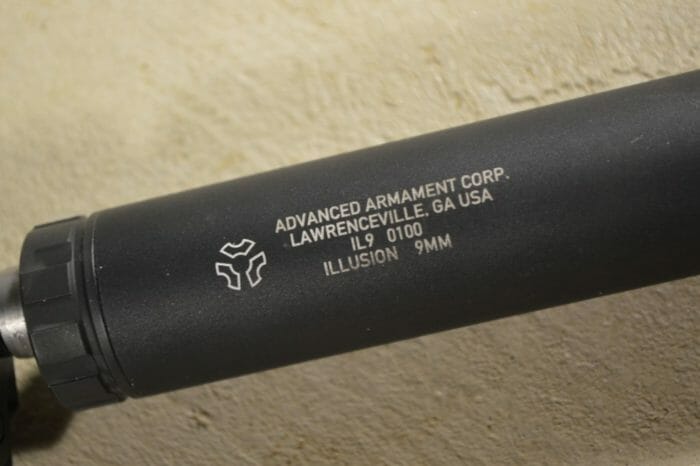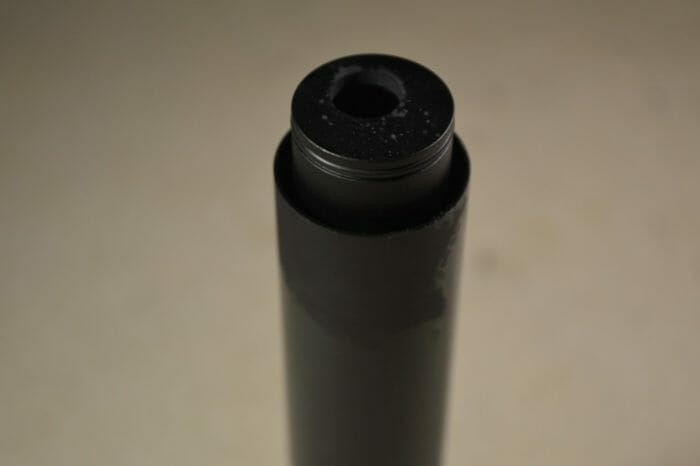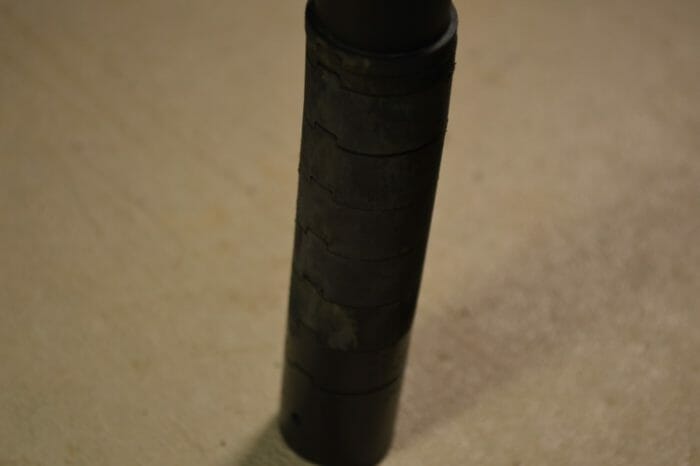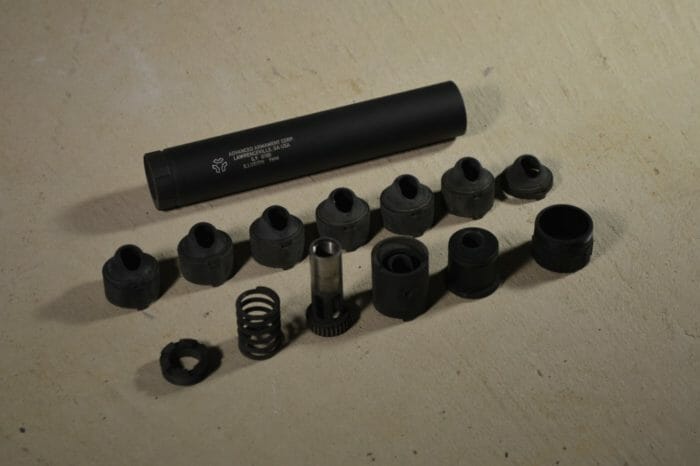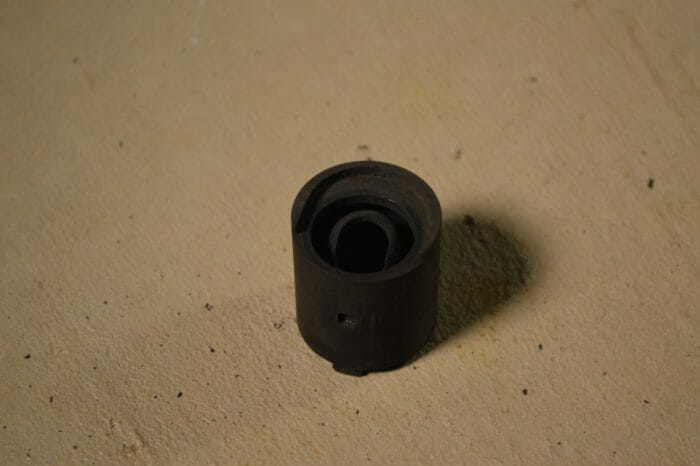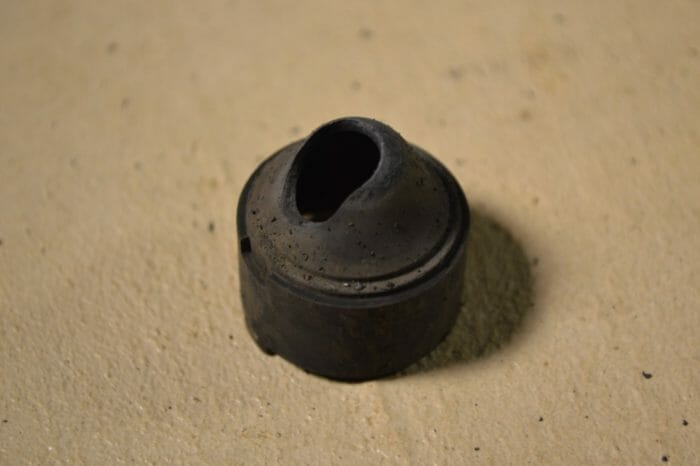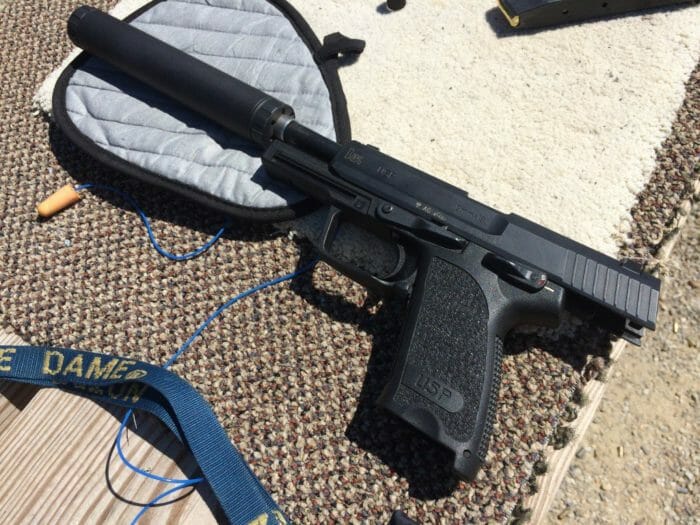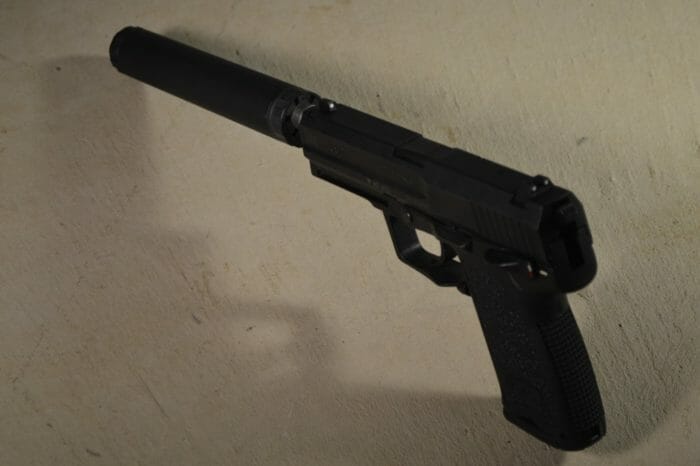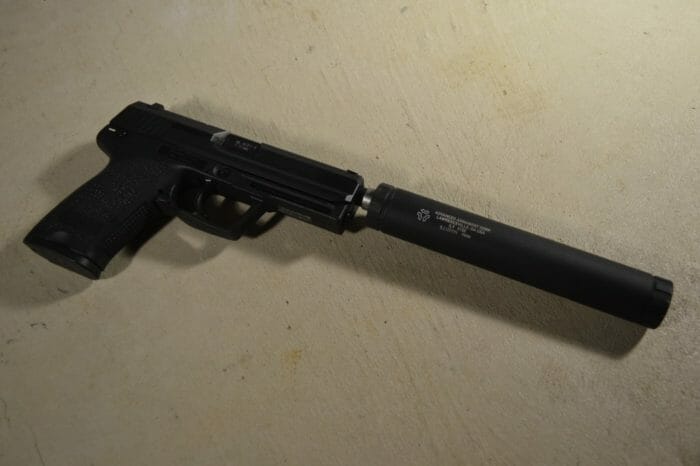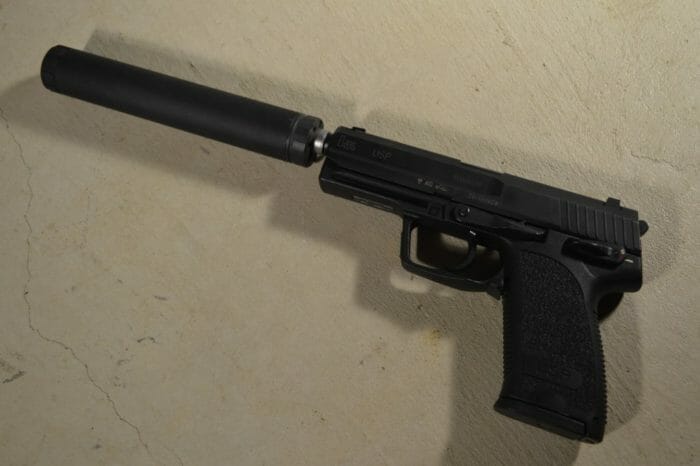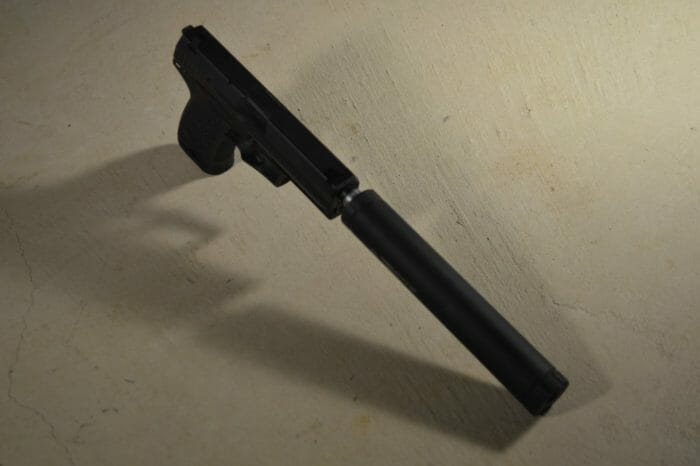Silencer Shop Authority: AAC Illusion 9 Review
Intended to compete against SilencerCo’s Osprey series of silencers, the AAC Illusion is also a pistol-centric can with an off-center bore. Though we often categorize these oddball suppressors as “eccentric,” off-center bores date back to Maxim’s original 1909 silencer patent and, as a result, are in some ways more traditional than many of us think. More recently, eccentric suppressors have gained popularity as dedicated pistol silencers for shooters who still want to use standard sights, and up to now, SilencerCo was the only company to offer such a can. The AAC Illusion 9 represents the first real challenger to the Osprey’s hegemony. If my initial impressions mean anything, it looks like the SilencerCo Osprey has a real fight on its hands.
Size and Weight
Compared to most current generation handgun suppressors, the AAC Illusion 9 is relatively svelte. At a mere 1.25” in diameter, it is noticeably slimmer than the standard 1.375” pistol cans manufactured by most companies. The thin profile is certainly appreciated in an eccentric suppressor that is intended to facilitate standard sight usage.
Readers that are well versed in suppressor design are bound to wonder whether or not the smaller tube (and reduced volume) hinders the Illusion 9’s suppression capabilities. The answer is absolutely yes, and the disadvantages are noticeable, but perhaps not to the degree that I expected. We will explore this issue more in the Range Report section of this review.
To compensate for the slender tube’s reduction in volume, AAC chose to make the suppressor nearly 8 inches long (7.75”). This puts the Illusion 9 on the upper end of the 9mm silencer length scale. If you are looking for a compact 9mm silencer, this is probably not your answer.
Even as a reasonably long can, the Illusion 9 is a pleasingly light 9.7 ounces. Since a stack of seven aluminum ones follows the stainless steel blast baffle, the total weight of the can is well below those with fully stainless guts. This translates to reduced durability and slightly more limited cleaning options, but the weight savings are greatly appreciated on a dedicated pistol suppressor.
Mounts
As a pistol suppressor, the Illusion 9 mounts to a handgun using a threaded piston assembly (Nielsen device). Currently, pistons are only available in 1/2×28 standard thread pitch, but I would expect 13.5x1mm metric pistons to be available very soon. Additionally, Beretta 92 users will need an extended piston (yet to be released) for the Illusion to clear the pistol’s guide rod. Since the Illusion is an eccentric design, ensuring that it indexes correctly when tightened down is essential. Thankfully, proper orientation can be achieved by tightening the suppressor to the firearm, pulling forward on the tube, and rotating it until the sights clear the top of the can.
Interestingly, the piston wanted to index against the muzzle of my USP’s threaded RCM barrel. This did not seem to be a problem during use, but I would have preferred for it to snug against the shoulder of the threads. I cannot say with any certainty whether this issue is caused by shallow threads in the piston or long threads on the RCM barrel. Both SilencerCo suppressors in my possession, tighten all the way to the shoulder.
Overall, the piston system is very simple and quite similar to other popular suppressors, but it is not perfect. I found that when the Illusion gets dirty after a few hundred rounds, the piston can become extremely challenging to remove. Because of this fact, Illusion owners will want to clean the Nielsen device frequently.
One cautionary note I want to leave with readers is that we are unlikely to see fixed barrel mounts or 3-lug adapters for the Illusion. The suppressor is intended to be a pistol silencer, and the limited space inside the 1.25” tube, combined with the off-center bore, means that a 3-lug mount probably cannot fit inside the can. Similarly, indexing the suppressor with a fixed barrel mount would be challenging or unfeasible. Since the piston system is similar to the one used by SilencerCo in the Octane and Osprey lines, shooters might be able to devise some sort of metal tube similar to SilencerCo’s fixed barrel spacer that would replace the spring and could lock the piston. Even so, this would not guarantee that the suppressor indexes appropriately when attached to the firearm. Readers should take the above merely as speculation, not official word from AAC or Silencer Shop, but I feel fairly confident that reality will limit the Illusion’s flexibility.
Design and Materials
Because it is an eccentric suppressor, the Illusion 9’s bore is drilled off-center in order to facilitate the unfettered use of standard pistol sights with the suppressor mounted. The Illusion is undoubtedly a niche suppressor and competitors are limited to SilencerCo’s Osprey, but AAC executes the dedicated pistol silencer better than anyone to date. The Illusion sits significantly lower than the Osprey, meaning it obstructs far less of the sight picture. Whereas only a few standard sight configurations actually clear the Osprey, everything I tried (USP, M9, 1911 Bomar style) with the Illusion cleared with no problem. The entire point of the eccentric design is to bring the can down low enough to prevent interference with the standard sight picture and so far, AAC is the only company to actually meet this goal.
Breaking down the Illusion 9 is slightly more challenging than many traditional suppressors, but the overall process remains the same. In order to remove the piston and spring, the included tool must be used to unscrew the retaining collar at the rear of the can. Once this is done, the piston and spring can be pulled out the back of the suppressor.
The baffle stack comes out the front of the can. To release the stack, unscrew the notched retaining ring at the front of the suppressor. After the ring has been removed, the entire baffle stack can be dumped out of the front of the tube. If the suppressor is dirty, a few baffles may stick and require light tapping from a dowel rod to remove. Readers will note from the images that the baffles all have indexing notches to ensure proper alignment. This is especially important considering the suppressor’s off-center bore. When reinstalling the stack, the end cap should sit recessed into the tube and will be flush with the edge of the tightened retaining ring. If the ring will not tighten all the way down, remove it and turn the end cap until all baffles fall into place. This design works well to establish proper alignment while maintaining easy serviceability.
As I mentioned previously, in order to facilitate the Illusion’s low profile, AAC elected to roll with a 1.25” diameter tube instead of the typical 1.375” size used by most traditional, current generation suppressors. This means less volume is available to capture the hot gasses that attempt to escape with each shot. In order to compensate, AAC made the Illusion a full 7.75 inches long. Based on what I have found in my studies, suppressor length generally has a greater impact on suppression than the diameter, and the Illusion’s performance seems to indicate that AAC’s design choices in this department were well thought out.
The Illusion baffles are intriguing, modified cones that are intended to siphon gas away from the bore line and towards the fat side of the can. Seven of the eight are machined out of 7075 anodized aluminum and the eighth is a 17-4 stainless steel blast baffle with a nitride finish. The piston is also made of 17-4 stainless steel and the suppressor tube is 6061 anodized aluminum. Considering the relatively low pressure of most 9mm loadings, the Illusion 9 should be plenty durable.
Given the odd configuration of the eccentric suppressor, cone baffles were probably the only realistic choice for the Illusion, aside from a monocore. An almost certain casualty of this design choice is that the Illusion exhibits more backpressure than AAC’s K-baffled Ti-Rant lineup. We will talk about this more in the Range Report, but the Illusion is gassier than its AAC brothers.
Range Report
Prior to testing the Illusion 9, my expectations for the suppressor were not all that high. The slim tube and eccentric design seemed like insurmountable tradeoffs that would relegate this suppressor to the low end in terms of performance. To my surprise, this absolutely was not the case.
After a noticeable, but not overwhelming first round pop (the video exaggerates this), the Illusion 9 sounds only slightly louder and somewhat higher pitched than the Osprey 9 I pitted it against. For reference, the ammunition I used was 147 grain subsonic 9mm reloaded by Freedom Munitions. When metered results are released by folks like Silencer Shop, expect this can to measure three or four decibels louder than the rival Osprey. The difference is just barely enough to notice. The tonal distinction between the two is slightly more obvious, but it is to be expected as the Osprey is a more voluminous can. With ear muffs or plugs, the two suppressors sound almost identical.
Because AAC opted for conical baffles, the Illusion 9 does have a bit more blowback than I expected. Shooting with the suppressor, my face was splattered with debris on a handful of occasions, but it was not an issue with every round. Obviously, the blowback was more exaggerated when I tested the suppressor wet.
Speaking of wetting the suppressor, I found adding a small amount of water did result in modest suppression improvements. Most notably, it helped to reduce the small first round pop. That said, firing the Illusion wet does not beat a wet Osprey in terms of sound reduction, and the wet blowback was a minor annoyance.
Lastly, the point of impact (POI) shift was a relative non-issue with the Illusion. While every suppressor seems to affect POI to some degree, the Illusion’s is negligible. Even with the pistol rested on a sandbag, I did not notice any change in where my bullets landed relative to my point of aim. Considering that POI shift is much more noticeable at longer distances, it is not surprising that we would not see much at typical pistol ranges (<25 yards). Based on my experience, I would say it is safe to assume that a properly indexed Illusion 9 will have no significant effect on POI.
Conclusion
To be honest, the AAC Illusion 9 really surprised me. I’ve never been a fan of eccentric suppressors and have been content to “sight through the can” with most pistols. The Illusion has changed my perspective, and I can now better appreciate the benefits and advantages of actually being able to see the target when shooting. Compared to other suppressors, like the Osprey, the Illusion is the only silencer that allows for full sight usage without specialized suppressor sights.
I was also surprised by the Illusion’s strong performance. I expected that AAC would have to surrender a certain amount of suppression to use a slimmer can with an off-center bore, but I was impressed by just how little they had to compromise. The Illusion does not match the Octane, Osprey, Ti-Rant, or other top performers, but it comes close enough. Indeed, it is just a bit louder and exhibits a somewhat higher-pitched report than these alternatives, but the difference is not huge. Compared to previous generation suppressors, AAC’s new offering looks like a king.
While positive in general, the Illusion story is not perfect. The can’s user serviceability is much appreciated, especially when many reloaders like to use cast lead bullets. Unfortunately, the piston system can be incredibly difficult to tear down when fouled. Moreover, as much as the aluminum baffles help to reduce weight, they also rule out some harsh cleaning agents that many shooters use for suppressor maintenance. Sadly, the only real alternatives would have been expensive titanium or heavy stainless, so aluminum baffles were the logical choice for AAC. Because we likely will not see fixed barrel mounts or 3-lug adapters, the Illusion 9 is for me, solely a pistol suppressor. It is not a do-it-all silencer in the same way that many traditional options are. In my mind, this makes the Illusion an ideal second suppressor for those that already have a pistol caliber can.
If I find myself in the market for a dedicated pistol suppressor sometime in the near future, AAC’s Illusion will absolutely be on a very short list of suitable options. The suppressor was impressive in testing, and I consider user serviceability a real asset for pistol cans. Readers who would rather not swap sights on all their host pistols and who do not want to aim through the can should absolutely give the AAC Illusion 9 some strong consideration. Interested readers can find the Illusion 9 starting at $677 from Silencer Shop.
An information security professional by day and gun blogger by night, Nathan started his firearms journey at 16 years old as a collector of C&R rifles. These days, you’re likely to find him shooting something a bit more modern – and usually equipped with a suppressor – but his passion for firearms with military heritage has never waned. Over the last five years, Nathan has written about a variety of firearms topics, including Second Amendment politics and gun and gear reviews. When he isn’t shooting or writing, Nathan nerds out over computers, 3D printing, and Star Wars.

